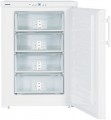Capacity
The total working volume of the freezer compartment. A larger volume allows for more products to be stored, but it affects the size and cost of the unit; therefore, when choosing based on this parameter, it's important not to chase maximum capacity but to consider what volume you actually need. For example, for household use, the average necessary volume is 50 liters per person; and when choosing a display freezer (see "Type"), you need to consider the number of products to be sold. More detailed recommendations for selecting the optimal volume can be found in specialized sources.
It is also worth considering that the freezer is often divided into several compartments (see below) — which means that a large volume does not necessarily guarantee that large pieces of products can fit into the device.
Number of compartments
It is the number of compartments provided in the design of the freezer. In some models, it is possible to set different temperatures for different compartments. It is worth noting that a large number of boxes does not always mean maximum convenience, since, with an increase in their number, the volume of each individual box inevitably decreases.
Max. temperature
The highest temperature maintained by the freezer during normal operation. This parameter is not as important as the minimum freezing temperature, however, it allows to evaluate the optimal conditions for storing certain categories of products that do not need deep freezing. And in some cases, it shows that the freezer can
work as a refrigerator.
Minimum temperature
The lowest temperature that the freezer can maintain in normal operation. First of all, the duration of food storage in the freezer depends on this parameter: it is believed that a temperature of -12 ° C is enough to preserve food for a month, -18 ° C – 3 months, -24 ° C – up to a year. At the same time, it must be taken into account that not only temperature affects the shelf life but also the type of product and its quality before freezing.
Power failure autonomy
The amount of time the freezer keeps food cold enough when the refrigeration system is turned off, for example, due to a breakdown or power outage. Technically, the power failure autonomy for each model is calculated differently; For example, for a freezer with an operating temperature of -18 ° C, this is the period during which the products in the chamber heat up from -18 ° C to -9 ° C. To sum up, the time is indicated during which the frozen products are guaranteed not to heat up to a temperature at which they could lose their properties.
Hidden door handle
A handle made in the form of a notch at the end of the door. Thanks to the
hidden handle, the freezer at least gets a neat, discreet appearance — with a minimum of unnecessary details on the doors. In addition, a traditional handle can be touched by careless movement, but with a hidden one, it is impossible. It is especially relevant in cramped conditions.
Child lock
The child lock allows you to block freezer controls and/or access to its internal volumes. This function will be useful in families where there are small children. Thus, the child will not be able to get to the freezer controls and change its operation mode.
Cold accumulators
The presence of removable refrigerants (cold accumulators) in the freezer design. This solution allows you to extend the temperature retention time in case of a power outage and also allows you to take it with you for use outside the freezer if necessary.
Energy class
The energy class shows how economical the freezer is in terms of electricity consumption. Initially, the classes were designated in Latin letters from A (most economical) to G (high power consumption). Recently, improved classes A+, A++ and A+++ appeared (the more pluses - the more economical the device).
It should be borne in mind that this indicator represents not the actual energy consumption but the efficiency of the unit compared to similar models. Therefore, a small class A freezer may have a lower power consumption than a large class A++ model. And other things being equal, a more economical device, as a rule, costs more, but this difference can quickly pay off during the operation.

